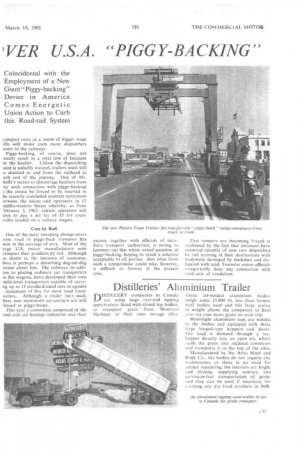UNION SD 'VER U.S.A. "PIGGY-BACKING"
Page 68

Page 69

If you've noticed an error in this article please click here to report it so we can fix it.
Coincidental with the Employment of a New Giant" Piggy-backing" Device in America Comes Energetic Union Action to Curb this Road-rail System
AFEARSOME-LOOK1NG objec rubber-tyred but in appearance mo like a bridge than a road vehicl has recently made its debut upon th
American haulage scene. Called tl Paceco Trans Trainer, it has a maximui speed of 3 m.p.h. and top weekly total ( 30 miles, and is the latest innovation fc transferring piggy-back " cargo carrie from trucks to railway cars. It is clairne that containers weighing up to 30 tor can be handled more smoothly and fast( by this device than by conventions methods.
The Paceco Trans Trainer is made b Pacific Coast Engineering Company. 1: four tyres, made by the B. F. Goodric Tyre Company, are of Rock Service nylo construction, size 18.00-25 with 28-ph rating. They operate on individual whee: and axles (looking like huge casters), an support the mobile gantry crane and ii cargo weighing up to 70,000 lb. Tyr inflation pressure is 110 p.s.i.
The first model of the Trans Traine now in daily service at the Matson Nay. gation Company's Encinal Terminal: Alameda, California, transfers a 25-to cargo container from storage pavemer to vehicle chassis in only two minute It can travel down a train, loading an unloading as it goes, without losing rim to back off or make trips the length c the train to move and deposit the cargc
The Trans Trainer stands 24 ft. big with a 21-ft. wheelbase. It can stac containers two units high to save valuabl space. It will also handle logs, missile boats, timber, tanks, vessels, and othe large cargo units.
Easy Tyre Changing The tyres cushion the heavy load! allowing the huge crane and its cargo t move on docks and paved surfaces with out damaging the roadway. Tyre chant ing is made easy by the single-wheel sus pension and frame jacking pads supplie for lifting the corners.
Of coincidental, but closely allied, intei est is a transport development in th U.S.A.
Energetic measures are being sought b Mr. James R. Hoffa, president • of, th powerful International Brotherhood o Teamsters, to curb the growth of " piggy backing "—the practice of transportin goods in' road semi-trailers mounted ape railway wagons.
During 1960, some 560,000 wagon were thus loaded—a 35 per cent. advanc over 1959 and 31 times as many as 1 1955. While railway officials happily ave that the piggy-back potential is as ye scarcely scratched, Hoffa's union mourn the loss of 20,000 members over the las two years as a direct result of the practice Ironically, the drivers themselves wit: their current wage claims are unwitting] furthering the cause of piggybacking, fo the almost certain increase in roa ransport rates. as a result of bigger wage
• ills will make even more dispatchers esort to the railways.
Piggy-backing, of course, does not isually result in a total loss of business
or the haulier. Unless the dispatching oint is suitably located, trailers must still e shuttled to and from the railhead at ach end of the journey. One of Mr. foffa's tactics to discourage hauliers from ny such connection with piggy-backing 5 the clause he forced to be inserted in he recently concluded contract agreement oetween the union and operators in 12 aiddle-western States whereby, as from 7ebruary 1, 1962, vehicle operators will iave to pay a set fee of $5 for every railer loaded on a railway wagon.
Cars by Rail One of the most sweeping change-overs corn road to piggy-back transport has eeti in the carriage of cars. Most of the arge U.S. motor manufacturers now ransport their products by rail. Although to doubt in the interests of economy, here is perhaps a disturbing dog-eat-dog avour about this. The railways, inaddiion to placing ordinary car transporters in flat wagons, have developed their own nulti-level transporters capable of carryrig up to 15 standard-sized cars as against maximum of five for most road trans iorters. Although a trailer isn't used, hese new mammoth car-carriers are still lassed as piggy-backs.
This year a committee composed of the Dad and rail haulage industries and their unions, together with officials of interState transport authorities, is sitting to hammer out this whole vexed question of piggy-backing, hoping to reach a solution acceptable to all parties. Just what form such a compromise could take, however, is difficult to foresee at the present time. That tempers are becoming frayed is evidenced by the fact that instances have occurred recently of new cars dispatched by rail arriving at their destinations with bodywork damaged by buckshot and disfigured with acid. Teamster union officials categorically deny any connection with such acts of vandalism.












































































































































